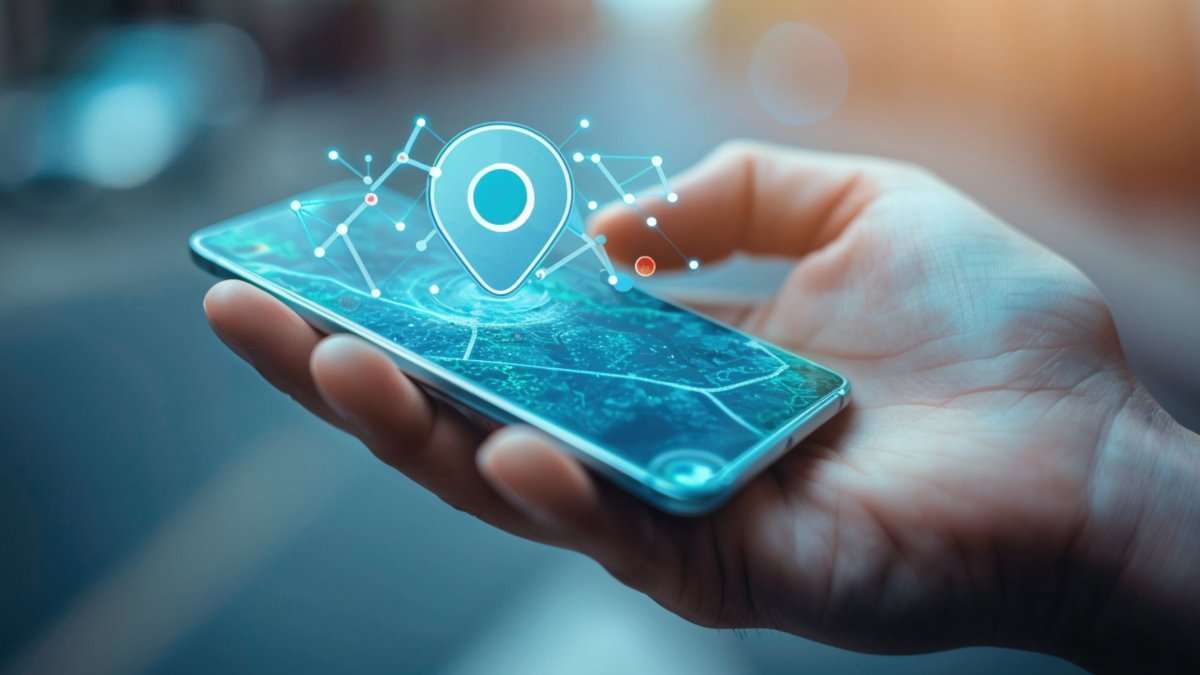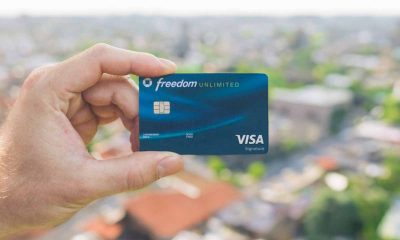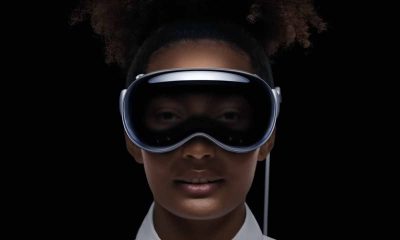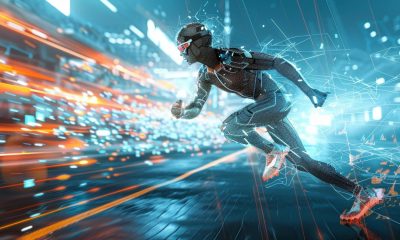Local News
How Intel’s AI platforms are making the Olympic and Paralympic Games more accessible – NBC Los Angeles

[ad_1]
The following content is created in partnership with Intel. It does not reflect the work or opinions of the NBC Los Angeles editorial staff. Click here to learn more about Intel.
Some 15,000 athletes and as many as 15 million spectators are expected at the Olympic and Paralympic Games this summer. That means countless things to discover among dozens of venues—and countless ways to get lost.
Wayfinding is something many of us take for granted nowadays. With the widespread availability of wayfinding applications that provide real time maps whether you’re navigating city traffic or blazing a trail through the mountains, it’s easy to forget that live maps don’t work indoors, since the relatively weak satellite signals are blocked by large structures. While that’s a problem for all users, it’s even more of a challenge for those who may be blind or vision impaired.
An indoor wayfinding solution, powered by Intel AI platforms, will be deployed at Paris 2024. But it’s only the beginning. The project has an ambitious goal of mapping all the world’s interior spaces to better serve anyone who’s ever needed to navigate an unfamiliar indoor space.
“We’re specifically looking at how Intel technology can help people with disabilities, but it’s a universal tool as well,” says Jocelyn Bourgault, Intel’s Paris 2024 Team USA and Accessibility Programs Lead. “Even people without disabilities can gain access to it and to its benefits.”
Wayfinding at the Olympic and Paralympic training sites
Two activations will be in place at the Olympic and Paralympic Games this summer, serving athletes and staff at the Team USA Training Site in Paris, and at the International Paralympic Committee headquarters in Bonn, Germany.
Within those venues, users will be able to experience rich indoor wayfinding via a smartphone app. With the ability to search locations, enter a specific destination, or explore predefined points of interest (POIs), sighted users can choose to follow a 3D camera view through the space with an overlay of arrows on a live map, while visually impaired users can choose a 2D map view, along with audio cues, or a dark view that relies entirely on audio.
Even more granular functionality can support wheelchair users who, for example, might want to choose a route that includes ramps and elevators rather than stairs, while someone on foot can select a shorter or faster path. And as with familiar mapping applications, users can set up a route that includes stops along the way, such as at a coffee kiosk on their way to a meeting.
“We’ve created paths that allow the athlete to find their way from the minute they get off the bus: let them find their coaches immediately, get into training if that’s where they’re headed or the hot tub for rehabilitation or the physical therapy room,” says Bourgault. “We’re hoping that the athletes are going to be able to use this app to really maximize their time and, you know, focus on getting that gold medal.”
Developed as part of Intel’s unified Environmental, Social and Governance efforts, the system is very different from indoor mapping systems that rely on Bluetooth beacons and has a far simpler setup. Rather than needing to place dozens of beacons in a space to provide reference points, the process requires only LiDAR scanning of a space. A walkthrough with a 360-degree Lidar Scanner is enough to capture the interior (depending on the size of the structure, that can take a team of surveyors a day).
The resulting data point cloud, capturing the geometry of the physical space, is sent to the cloud, where machine learning algorithms trained on large datasets and running on Intel® Xeon® processors translate that point cloud data into a digital twin of the space, identifying and categorizing objects and features along the way, faster and with much higher accuracy and precision than traditional methods. That data is sent back down to edge devices, where machine learning algorithms create the actual maps for users moving through the space. And it’s all powered by Intel® AI platforms from the Intel® distribution of OpenVINO™, an open source toolkit for deploying AI on systems powered by Intel® Xeon® processors.
“We’ve been working with our partners to showcase the performance of our CPUs using OpenVINO™ in their machine learning algorithms,” says Bourgault. “And so far, the test results are incredibly positive. OpenVINO™ plus Intel® Xeon® processors is a match made in heaven.”
Further scanning can add up-to-date navigation information as elements within the space change. For example, concession stands, bleachers, staging, and other temporary structures might be set up for one event and reconfigured for another. But those subsequent scans are much faster and less data intensive.
We’re specifically looking at how Intel technology can help people with disabilities, but it’s a universal tool as well. Even people without disabilities can gain access to it and to its benefits.
Jocelyn Bourgault, Intel
Finding the future of accessibility
The Olympic and Paralympic Games activations build on previous demonstrations of the technology at a university and an international airport. And as more large-scale installations roll out, it’s clear that there are multitudes of possibilities unlocked by dependable indoor wayfinding—from transit to retail, healthcare, government, and education.
“It’s the curb-cut effect,” says Bourgault. “Think about how a curb cut helps a disabled person get from one sidewalk to another. But once they were adopted nationwide, people realized that they don’t just help people with disabilities, they help the mother with a stroller, the kid on a trike, the delivery driver with a cart of packages. And there are lots of examples where solutions that help people with a specific disability have wide-ranging benefits for the whole community.”
Future integrations will be deeper and broader. Collaborations with outdoor mapping providers will link indoor systems into the wider world of wayfinding, opening possibilities for use in transit systems, large campuses, and, of course, across all the competition and training venues of future Olympic and Paralympic Games. And they will require the sort of extremely fast, high-capacity processing capabilities such as what Intel® Xeon® processors provide.
“What we’d like to have,” says Bourgault, “is a handoff, or handshake, between this indoor navigation system and existing outdoor navigation systems. To really make the world accessible, you need collaborations to create that seamless interaction between the spaces.”
The incorporation of live data has even more potential. Sarah Vickers, head of Intel’s Olympic and Paralympic Games Program, envisions future applications that involve continual updates with live data, enabling actions such as adjusting suggested paths to account for crowded concessions or restroom lines or busy transit stops, or directing users to retail, informational, or cultural points of interest. There are countless opportunities for optimization and efficiency—and most importantly, to provide a better user experience. “There are so many different things you can do,” says Vickers. “If you can sync this with real time data. It’s going to be really helpful. The more we can feed into that to help people, the better off it’ll be.”
Learn more about the ways Intel’s AI platforms are powering the Olympic Games.
More from this series:
[ad_2]
Source link
Local News
How the homeless can vote in Los Angeles County and across California – NBC Los Angeles

[ad_1]
Latinos, women and independents are among the voting blocks often discussed during elections.
One woman tells the NBC4 I-Team it is time to consider the homeless, a group she was once a part of.
The last count found more than 75,000 people are homeless in Los Angeles County and many of them may not realize that they can register to vote, including at county shelters and online.
“The main thing I feel for any homeless person, is you have to learn to become vocal, you know? That’s why we are invisible, because a lot of us tend to be so embarrassed, we don’t want to reach out for help,” Justice Butler said.
The 65-year-old former radio disc jockey says she found herself homeless at various times in her life, from her hometown of Houston to Los Angeles. She now lives in a studio apartment near McArthur Park.
One thing that never waned was her desire to be part of the voting process.
“It means a lot every year, because the first time I’m voting, and I’m teary-eyed because of the people before me, and I’ve really learned to connect to my history,” Butler said. “They died and fought for this right to vote.”
Butler registered to vote while at a Los Angeles city shelter.
“When I went into the shelter on Skid Row, they gave me all this paperwork to fill out, and one of it was a voter registration card,” she said.
Her story is not unique.
California law allows an unhoused or homeless voter to participate in the election, said Dean Logan, who oversees the Los Angeles County Registrar-Recorder/County Clerk.
“They can register to vote, they can list the cross street where they spend the most of their time, where they lay their head at night,” Logan said.
“They can list the shelter where they’re staying for residents’ purposes that ensures they get the most localized ballot that’s effective for them,” he added.
Logan tells the NBC4 I-Team, currently there are about 800 voters registered with an intersection address and then another approximately 5,500 voters who registered with a shelter, a church or similar place that provides services.
Still there is the fact that every active registered voter in California receives a vote by mail ballot.
“So you can list a mailing address. So a lot of those voters may list even a Department of Social Services address where they’re receiving information about their benefits or they can use a shelter address or a PO box to receive the voting materials,” Logan said.
He says the fail-safe method remains the in-person vote centers, including mobile ones that the county sends to different neighborhoods.
“We utilize that program to also go to homelessness encampments that are in North County or out in Long Beach or areas like that to ensure that we have access for those voters,” he said.
The need goes beyond the homeless population.
“This is a particular issue in this election because we know that there are a group of citizens who through the end of rent control after the pandemic have been displaced from their homes and may not receive their voting materials because they’re dealing with trying to find a new home or a new place to stay,” Logan said.
Butler says she is battling a debilitating lung disease and is focused on issues that matter to her this election.
“It’s about somebody having a plan for healthcare,” she said.
Her message to others, no matter where they live is, is to vote.
“We got to go out to vote,” she said. “This time, we got to go out and vote, y’all, real.”
Vote by mail ballots have been mailed out. Some of the dozens of in-person vote centers in Los Angeles County will open as soon as 11 days before election day and people can vote at any location, even registering on site.
[ad_2]
Source link
Local News
Dodgers can’t overcome early six-run deficit in 7-3 loss to Mets in Game 2, NLCS even at one game apiece – NBC Los Angeles

[ad_1]
October baseball is infamous for its unscripted nature. Just when you think you can predict the outcome, a literal curveball gets thrown at you, flipping the script, turning everything topsy-turvy.
The Los Angeles Dodgers threw a bullpen game with their season on the line in Game 4 of the NLDS against the San Diego Padres.
Pundits, analysts, and experts alike all said it would be the end of the 2024 Dodgers. Instead, eight different relievers combined for a shutout, extending their season and their scoreless inning streak.
Jack Flaherty and the bullpen threw another shutout in Game 1 of the NLCS on Sunday to tie the MLB record of 33 consecutive scoreless innings in the postseason. So another bullpen game in Game 2 with the same relievers lined up should reproduce the same results, right?
Wrong.
Francisco Lindor snapped the scoreless streak with a leadoff homer in the first, and Mark Vientos broke the game open with a grand slam in the second, and the New York Mets defeated the Dodgers 7-3 in Game 2 to even the best-of-seven NLCS at one game apiece.
“Everything is great when it works well and guys are throwing up zeros, but you’re still facing really good ball clubs,” said Dodgers’ manager Dave Roberts of the bullpen game in Game 4 of the NLDS compared to Game 2 of the NLCS. “And there is a margin that you have to guard against and kind of really appreciate the cost of the next games, and not forgetting that this isn’t a winner-take-all game. It’s not a three-game series.”
Ironically, everyone in the extended baseball multiverse spent the last 24 hours praising the Dodgers pitching staff and wondering when or if they would allow another run.
Flaherty said the pitchers were “feeding off each other,” after Game 1. On Monday they got eaten alive by the “OMG” Mets’ hitters.
Lindor, likely the runner-up for MVP in the National League to Dodgers’ designated hitter Shohei Ohtani, hit the Mets sixth leadoff homer of the season, and first in the playoffs since Curtis Granderson in Game 5 of the 2015 World Series, when he crushed a cutter from opener Ryan Brasier sending the ball soaring into the New York bullpen for a 1-0 lead.
LEADOFF LINDOR LASER 💥 #NLCS pic.twitter.com/nDvDghuYti
— MLB (@MLB) October 14, 2024
Los Angeles went to right-hander Landon Knack for length, but instead of keeping the game close, he opened the flood gates, surrendering five runs in the second inning, including a back-breaking grand slam on the ninth pitch he threw to Vientos.
MARK VIENTOS GRAND SLAM
THE @METS ARE RAKING IN LA 🤯 pic.twitter.com/DIQYRNusVa
— MLB (@MLB) October 14, 2024
“I really didn’t have a feel for things. I just wasn’t sharp today,” said Knack of what happened in the second inning. “I wasn’t able to execute pitches the way I normally do. I wasn’t able to put guys away. I kept leaving things middle.”
From that moment on, nothing happened on Monday afternoon that echoed anything that preceded it. The Dodgers scorching hot offense, that had produced 19 runs over their last three games, went dormant. The dominant pitching staff was ineffective and subordinate.
Ohtani, who was 2-for-4 with two RBI and two runs scored in Game 1 was hitless with two strikeouts in Game 2.
“I thought he didn’t look comfortable versus Manaea,” said Dave Roberts of what he saw from Ohtani at the plate today. “The heater is away. You can see he was just kind of trying to keep the ball away from Shohei.”
Sean Manaea, who entered the game with nearly an 8.00 ERA against the Dodgers in his career, silenced the most-lethal lineup in the Majors for the better part of five innings.
“He’s a really good pitcher,” said Mookie Betts of Manaea on Monday. “He’s been pitching really well lately and has a lot of confidence. He threw the ball well again today. We lost. It sucks. I don’t think anyone here was expecting them to roll over. We have to turn the page and prepare for Game 3 now.”
Manaea, who changed his arm angle in the offseason, delivering his best season since 2019 with the Oakland Athletics, allowed three runs (two earned), on two hits with four walks and seven strikeouts in five innings of work.
Sean Manaea revamped his delivery to throw from a lower arm angle.
It seems to be working 👀 pic.twitter.com/TR49LsfJYu
— MLB (@MLB) October 14, 2024
Maybe it was the early start time that did the Dodgers in. The Mets, who are still on Eastern Standard Time are accustomed to afternoon starts. Los Angeles hasn’t had one since the final game of the regular season on September 29th.
The Dodgers have spent the past decade monopolizing the Majors with a businesslike attitude. Stoic and forceful, less emotion, and more determination than their counterparts, they looked lackadaisical and lost in Game 2, like the drowsy sleeper who keeps hitting snooze on their alarm clock.
It took five innings for the Dodgers to finally awaken from their slumber. Max Muncy put the boys in blue on the board with a solo shot in the fifth inning, his 12th career postseason homer, tied for second on the Dodgers all-time list.
Max Muncy puts the @Dodgers on the board with a solo shot #NLCS pic.twitter.com/bTVXB5B81P
— MLB (@MLB) October 14, 2024
Los Angeles cut the lead in half thanks to a pair of walks and some bad defense by the Mets.
Tommy Edman drove in two runs when a ball bounced off the glove of first baseman Pete Alonso, but the rally ended when Enrique Hernández hit into a double-play with the bases loaded two batters later.
The @Mets get a HUGE double play to get out of the jam! #NLCS pic.twitter.com/gRxJvnxMru
— MLB (@MLB) October 14, 2024
Hernández had another opportunity to tie the game with runners on second and third in the bottom of the eighth, but he popped out to shallow right field to end the inning.
The Dodgers were 1-for-9 with runners in scoring position in Game 2 and left a total of ten runners on base in the loss.
“We’re never out of the fight,” said Dodgers’ catcher Will Smith of the missed opportunities.. “We were one big swing away from tying the game or taking the lead. As long as we keep giving ourselves opportunities like that we’re going to be okay.”
The Dodgers better sound the alarm when they head to Citi Field on Wednesday for Game 3, or they will be in danger of falling behind in this series. That’s not something they want to do against the team that had the most ninth inning comebacks in baseball this season.
Before Game 1 of the series, Muncy said his team needed to keep the fire and intensity that allowed them to win back-to-back elimination games to advance past the powerful Padres. But instead of fire and intensity, it was lethargy and fragility on display in Game 2.
The Mets had much better at-bats than the Dodgers, saw more pitches, showed more fight, and overall looked like the better team on the diamond. Oh, what a difference a day makes.
Momentum is only as good as the next day’s starting pitcher, and the Dodgers didn’t have one.
Their starting rotation is in shambles, injured beyond recognition, with only one pitcher, Yoshinobu Yamamoto, still standing from the Opening Day rotation, and even he missed nearly three months of the season with a rotator cuff injury.
Now the Dodgers will turn to the inconsistent, but battle-tested Walker Buehler in Game 3. Coming off his second Tommy John surgery, Buehler was 1-6 with a 5.38 ERA in 16 games this season. He allowed six runs in the second inning against San Diego in Game 3 of the NLDS. Manager Dave Roberts believes in him and is banking on his past history of big game performances.
“I like Walker on the road,” said Roberts. “I talked to Walker yesterday, and he’s obviously never lacked for confidence, but he’s in a good place physically, and he certainly lives for the big moments. What better way to change the bad taste that you had in the regular season for him to have a dominant postseason, and he’s on a heater right now.”
Whether it’s a heater or a luke-warmer, however it looks, the Dodgers need Buehler to deliver a gem in Game 3. If so, they’re back on-line with Yamamoto going in Game 4 and Flaherty on regular rest in Game 5.
It’s funny how fast things can change in a playoff series. 24 hours ago, the Dodgers looked unbeatable, now they’ve lost home-field advantage and their pitching staff has been quelled. But tomorrow is another day, and another opportunity to flip the script. The rest of this series is still unwritten.
Game 3 of the best-of-seven NLCS between the Mets and Dodgers is scheduled for 5:08 PM PT on Wednesday, October 16th at Citi Field in Queens, NY. The game will air live on FS1.
[ad_2]
Source link
Local News
Riverside County sheriff – NBC Los Angeles

[ad_1]
Riverside County Sheriff Chad Bianco said Monday he stands by his comments over the weekend when he said his deputies may have prevented a third assassination attempt on former President Donald Trump, though a federal law enforcement source told NBC News there’s no indication that there was an attempt to assassinate the former president.
Deputies arrested 49-year-old Vem Miller of Nevada on state weapons charges a quarter mile from the rally. The arrest in Coachella, California, took place before the former president arrived.
“We do know that he showed up with multiple IDs, an unlicensed, unregistered vehicle with fake plates and weapons and ammunition,” Sheriff Bianco said. “In the end ,we found the person with all those monstrous red flags and we were able to arrest him on weapons charges and get him away from the facility before the president got there.”
Bianco’s comments come one day after his weekend press conference where he said he believed another assassination attempt on Trump had been prevented.
But on Monday we also heard from Miller, who is now out of jail after posting bond.
“I am releasing this statement because of the false information that is currently being released,” Miller said in a video shared on Rumble.
In the video, Miller shared that he’s a longtime supporter of former President Trump.
“Since 2000, I’ve been involved in the Republican Party in Nevada,” Miller said. “I am a Trump caucus captain, I have collected votes for Donald Trump, and I’m also a Trump team leader.”
NBC News was not able to verify Miller’s claim that he worked as a Trump caucus captain or a Trump team leader and that he was invited to the rally.
He said that he was in Coachella working as a journalist for the America Happens Network and always carries guns with him.
“In the trunk of my car I carry two firearms: One is a glock, one is a shotgun, and these two firearms that I carry for me are simply for protection,” he added.
Bianco wasn’t backing down.
“If he wants to say he was an innocent victim, then he also has to say how dumb it was to come out to believe that he could do all of those and try to get into that event, with guns,” Bianco said. “I don’t care if he’s a supporter of President Trump.”
“I’m very proud of my deputies and everything that they did there,” Bianco said. “We’re not making up anything that he did, we just caught him.”
[ad_2]
Source link
-

 News12 months ago
News12 months ago6 Ways To Attract a Rich Girl of Your Dream
-

 Finance11 months ago
Finance11 months agoWhich credit card is best for small businesses?
-

 Finance10 months ago
Finance10 months agoBest Business Credit Cards With 0% APR – February 2024
-

 Finance11 months ago
Finance11 months agoHow To Apply For A Chase Business Credit Card
-

 Finance12 months ago
Finance12 months agoLowe’s Credit Card: New Discounts on Lowe’s Purchases
-

 Finance11 months ago
Finance11 months agoLimited Time: Sign up for Chase Freedom Unlimited for a Year of Unlimited Cash Back!
-

 Entertainment12 months ago
Entertainment12 months agoNetflix Schedule January 2024
-

 Tech12 months ago
Tech12 months agoApple Vision Pro: $3,499 headset finally has a release date




